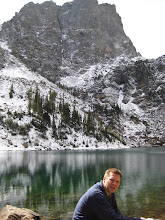
It took about an hour to trudge the two miles through northern Wisconsin woods to reach the spot on the south shore of Lake Superior.
Suddenly, we were walking near a cliff's edge, looking down several hundred feet to a field of ice chunks shifting and groaning along the shore. The ice pushed into the famous sea caves of the Apostle Islands National Lakeshore. We reached the area about an hour and a half before sundown, a piece of rich serendipity because the sun's light shined into the caves, and it brought out the rich browns and reds of the sandstone.
We stood there for a few moments, looking at the ice oozing out of the cliff walls, listening the lake ice murmuring as the cold water moved below it. I wish I had an audio recorder with me, because even though I try to recreate the sound in my mind now, three days later, I can't quite get it. I remember it as a combination of wind chimes and groaning, and for a moment, it felt like the lake was speaking right to me.
"Wow, it's no wonder the Indians thought the lake was a living thing," Kris said.
The spot is located about two miles north Meyer Beach on the Bayfield Peninsula, about 18 miles northwest of Bayfield.
During many winters, people are able to walk to the base of the cliff on the lake's ice. But this year has been too warm, and wind conditions have created the field of broken chunks that shift and crash into each other about a half mile along the shore. Beyond the ice was open water. A sign at Meyers Beach, put up by the National Park Service, strongly discouraged people from walking along the shore. We took that advice, although it was disappointing.
Even so, taking the overland route was interesting, and not without a bit of adventure. The trail was packed and well-used, but it was slippery, and as we got closer to the caves, it was easy to imagine one taking on false step and sliding into Lake Superior oblivion.
So I still want to see those sea caves close up. I think there might be a kayak trip this summer.
